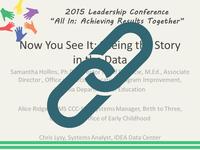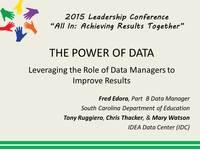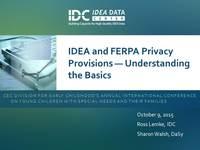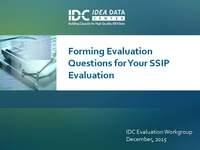Site Search
Results 15 - 21 of 158
Format: Presentations
Now You See It: Seeing the Story in the DataThis session demonstrated creative ways data are being displayed to tell the story of IDEA and other data. Participants heard from states that are displaying data in ways that tell data stories and convey meaning to stakeholders and the public. Participants also saw ways to access various online federal education data. This session offered participants online resources and websites about effective data displays.
Format: Presentations
Identified Significant Disproportionality – Now What?After a State determines that a district has significant disproportionality, what are the next steps? Presenters and session participants discussed how states can identify technical assistance and available tools and resources to help LEAs identify root causes and implement action steps, including CEIS, to make substantive improvement.
Format: Presentations
The Power of Data: Leveraging the Role of Data Managers to improve ResultsThis session examined the strategic role data play in state agency decision making by exploring how data managers can more effectively use their role to promote public reporting, data awareness, data utilization, and systems change. Presenters paid particular attention to data governance, cross-department information sharing, timely data access, distribution, usability, and analysis, along with examples of best practice from practitioners in the field to ultimately improve student results.
Format: Presentations
What Data Can Tell Us – and What It Can’t: How to Be Sure We Know What Our Data MeansValidity is about more than results—it is determined by the question asked, the data collection design, and analysis. In this session, presenters led a discussion on what the data can, and cannot, say about outcomes, using examples from a selection of Part B and Part C indicators. Questions posed included: What is the difference between student outcomes and program performance? Can your data tell you which states, districts, or programs are performing better? What policy questions would you like to know about that your data currently cannot answer?
Format: Presentations
National, State, and Local Educational Environments Data: Using the Data to Increase Inclusive Opportunities for Young Children Ages 3-5The session focused on current national and state data on least restrictive environments and inclusive settings for children aged three to five. Participants shared examples and discussed the ways in which they analyze and share data with local programs. In addition, discussions focused on how educational environments data are used to determine specific state and local program improvement strategies and supports.
Format: Presentations
IDEA and FERPA Privacy Provisions — Understanding the BasicsThis presentation informed participants of the privacy provisions under IDEA Part C, IDEA Part B, and FERPA. It covered the basics surrounding the legal requirements related to the protection of PII about children with disabilities and where to go for help with questions about privacy. The audience for the presentation included administrators and practitioners who are concerned with providing services for children and youth while maintaining the privacy of the children and youth they are serving.
Format: Presentations
Forming Evaluation Questions for Your SSIP EvaluationThis presentation focuses on the development of evaluation questions during SSIP evaluation planning.








